The Big Picture
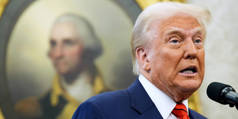
Donald Trump’s Misrule of Law
By insisting on its own supremacy, the executive branch of the US government under President Donald Trump is effectively seeking to alter America’s constitutional framework of checks and balances among co-equal branches of government. Trump has no authority to execute this change, but that will not be enough to stop him.
NEW YORK – US Vice President J.D. Vance recently declared that “judges aren’t allowed to control the executive’s legitimate power.” This shot, fired across the bow of the federal judiciary, threatens to disrupt a long-settled understanding that the courts should have the last word on what laws mean and require. Viewed against the backdrop of President Donald Trump’s constitutionally suspect executive decrees – such as ending birthright citizenship and dismantling Congressionally approved administrative agencies – Vance’s challenge throws into sharp relief America’s unfolding constitutional crisis.
At the heart of the matter lies a simple proposition: national elections are not constitutional conventions. Constitutional conventions are singular events that establish the fundamental norms and procedures that regulate the legitimate exercise of state power. In 1787, America’s Constitutional Convention worked out a political and legal blueprint that established a particular form of government (a democratic, federal republic) constrained by fundamental norms (individual rights and principles of due process and equal protection) that limit the exercise of state power, as well as a procedure by which the Constitution would enter into effect (ratification by the states).
Basic to the republic that the US Constitution established is the idea that in order to safeguard freedom against the threat of tyranny, the functions of government must be carried out by three co-equal branches, meaning that each branch is more or less autonomous in its singular function. Thus, Congress regulates policymaking and federal disbursements through its legislative function; the executive implements policy and defends national security; and the courts interpret what statutes and the Constitution require.
Through elections, the public determines who will represent their interests within this constitutional order. Elected officials cannot change that framework at will. For example, they cannot simply terminate elections or void the result of a free and fair election. Nor can they change the ground rules for the exercise of state power. For example, they cannot nullify individual rights or violate with impunity the principles of due process and equal protection.
Things get stickier, however, if an elected official, say, the president, decides that his (rather than the Supreme Court’s) opinion is dispositive regarding whether a particular executive order or action violates the Constitution. This controversy arose early in the new country’s history and was famously resolved in the landmark decision by the US Supreme Court in Marbury v. Madison (1803).
Writing for the Court, Chief Justice John Marshall ruled that “Questions, in their nature political or which are, by the Constitution and laws, submitted to the Executive, can never be made in this court.” On the other hand, legal questions – particularly matters involving the interpretation of the Constitution itself – fall within the province of the judiciary.
The iconic status of the Supreme Court’s decision in Marbury derives from the words that follow: “It is emphatically the province and duty of the Judicial Department to say what the law is. Those who apply the rule to particular cases must, of necessity, expound and interpret that rule. If two laws conflict with each other, the Courts must decide on the operation of each.”
In Marbury, for the first time, the Supreme Court asserted that it was the singular province of the judicial branch to have the last word regarding the Constitution’s meaning and whether particular legislative or executive actions conflict with its requirements. If the legislature thinks otherwise, which was the issue before the Court in Marbury, its authority must yield to the superior authority of the high court. The same goes for the president.
Unless it doesn’t. For example, in Worcester v. Georgia (1832), the Supreme Court held that the Indigenous Cherokee nation constituted an independent political community to which the laws of the state of Georgia did not apply. That meant that a missionary living among the Cherokee could not be prosecuted for refusing to take an oath to obey the laws of Georgia.
While the story (which Vance quotes) is likely apocryphal, President Andrew Jackson supposedly responded to the Court’s ruling by saying, “John Marshall has made his decision, now let him enforce it.” And, in fact, the Court’s decision did not prevent Jackson from sending in federal troops to evict the Cherokee from their land. The result was the Trail of Tears: a forced march to Indian Territory (now Oklahoma) that an estimated 10,000 Native Americans did not survive.
The resistance by Southern states to the Court’s authority to desegregate public schools, as mandated by Brown v. Board of Education (1954), tells a somewhat different story. Acting on the direct order of President Dwight D. Eisenhower, federal troops restrained a hostile mob and safely escorted young Black students (known as the “Little Rock Nine”) into a previously all white public high school.
But what if Eisenhower had chosen not to take action against the segregationists’ resistance to the Brown decision? The US surely would be a different country today.
The American republic currently stands at a similar crossroad. But the question is not simply what national policies the people’s elected representatives will implement. The larger issue is whether elected officials – either through direct action or strategic inaction – can change the constitutional order itself.
Vance’s opinion notwithstanding, it is well settled that within the US constitutional order “it is emphatically the province and duty of the courts [not the Executive] to say what the law is.” By insisting on its own supremacy, the executive branch under Trump is effectively seeking to alter America’s constitutional framework of checks and balances among co-equal branches of government.
Trump lacks constitutional authority to execute this change. Current circumstances suggest that the American people can restore the democratic republic their forebears founded only by asserting their original sovereign power, through elections, mass protest, or other forms of collective action.
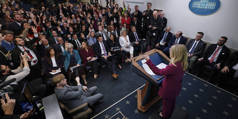
Trump’s Smoke and Mirrors
As Americans and the rest of the world adapt to another four years of constant chaos, it will be important to remember that Donald Trump's principal purpose in issuing any pronouncement is to gain attention. Unfortunately, much of the US media is uninterested in helping the public separate signal from noise.
BERKELEY – “It’s almost like they knew Trump was bluffing.” That is how Bloomberg columnist John Authers described Mexican President Claudia Sheinbaum and Canadian Prime Minister Justin Trudeau’s handling of the US president after he unjustifiably threatened their countries with 25% tariffs. The tariffs were postponed just before they were supposed to take effect. The reason, according to Kelly Ann Shaw, a former Trump adviser, was that America’s neighbors “came to the table … with commitments that sufficiently addressed the president’s concerns.”
But what did Sheinbaum and Trudeau offer? As far as I can tell, they committed to things that they had already committed to, albeit with some additional symbolic gestures – like a new Canadian “fentanyl czar” – thrown in. One is reminded of January 21, 2025 (a date that has already receded into the mists of time), when Trump announced that OpenAI, SoftBank, and Oracle would embark on a massive AI-infrastructure project that promises to create “more than 100,000 jobs almost immediately.” CBS journalist Jennifer Jacobs left that event believing that “the companies are expected to commit $500 billion into Stargate over the next four years,” even though “details of the new partnership were not immediately provided.”
In fact, there will be no $500 billion, and the partnership was not new (it was in the works long before Trump’s inauguration). Nothing close to $100 billion, let alone $500 billion, will be deployed immediately, and nothing close to 100,000 jobs will be created. Welcome back to the chaos that prevailed during Trump’s first presidency, in 2017-20.
But the next four years will not feature only chaos. The second Trump administration also will pursue policies with effects on the United States that will almost certainly be deeply harmful. Beyond deportations, tax cuts for the rich, symbolic measures to stoke the culture war (banning all mentions of “diversity”), and schemes to extort massive bribes from corporations and other private parties, it is anyone’s guess what the agenda will look like. But it would be wrong to conclude that Trump II is a paper tiger.
Whatever is coming, one must remember that the principal purpose of any Trump pronouncement is to gain attention. In every instance, slapdash ideas that provoke meaningful pushback – especially from the market – will be quietly dropped, as long as the immediate news cycle can close with a declaration of victory.
We saw Shaw provide such a declaration in the case of the tariffs; and Jacobs dutifully transcribed the purely aspirational $500 billion figure. Trump can now claim to have bested Joe Biden’s $280 billion CHIPS and Science Act, and Trumpists and other uninformed Americans will believe him. Yes, Elon Musk – who has been playing the role of co-president – immediately threw a tantrum following the Stargate announcement, pointing out that “they don’t have the money.” But this is a man who claims that all Teslas currently on the road will become fully automated driverless cybertaxis in the next two years.
How are those of us who want to inform the public and advance public reason supposed to react to all of this performative con-artistry, when we know that it is 90% mirage and 10% destructive chaos? Most of us are doing what we can. For example, Michael R. Strain of the American Enterprise Institute is out there on X (formerly Twitter) earnestly telling people that Trump’s threatened tariffs would probably be as destructive to the US economy as Brexit has been to the British economy:
“The Vice President argues that President Trump is looking out for the interest of American citizens. But these tariffs will raise prices for consumers and reduce employment opportunities for manufacturing workers. President Trump’s first trade war increased consumer prices. It reduced manufacturing employment and made domestic manufacturing less competitive. It failed to reduce the trade deficit. The second trade war is likely to more severely increase prices and reduce employment and competitiveness. The first trade war hit $380 billion of imports. This one hits $1.4 trillion. And economic integration with Canada and Mexico is substantial.”
Strain is absolutely correct. But what the US desperately needs is media outlets that take the trouble to discern which Trump pronouncements are backed by dedicated policymaking teams and bureaucracies with the intent to follow through, and which are not. As matters stand, too many respected outlets represented among the White House press corps are more interested in being part of the show than in assessing the play.

Breaking US Democracy Beyond Repair
Donald Trump is deliberately destroying faith in the system of government that has held together a vast and disparate country. By tearing down that civic religion, flawed as it may be, he is laying the groundwork for another quasi-religious faith: unquestioning fealty to an autocratic ruler.
NEW YORK – Compared to other Western democracies, the United States is still a profoundly religious country. Around 24% of Americans identify as evangelical Christians. Five US Supreme Court justices are conservative Catholics (the only other conservative on the bench, Neil Gorsuch, was raised and educated as a Catholic but is now an Episcopalian). And American presidents portray themselves as religious, regardless of their true beliefs.
A quasi-religious aura even hovers over the US constitution, which many Americans – including secular liberals – have long treated as a kind of sacred text, written by the country’s founders. After visiting in the early 1830s, French aristocrat Alexis de Tocqueville came to see Christian morality as an essential ingredient in US democracy: it created a kind of “civic religion” to balance the crude materialism of American life. Belief in a political system that guaranteed individual freedom based on the rule of law served as the connective tissue for a country of immigrants.
To be sure, America’s civic religion has always been contested and deeply flawed. It formally excluded Black Americans until the 1960s. White supremacy was, and remains, a major force in US politics – the defeat of the southern states in the Civil War didn’t change that. Religious zealots never accepted the separation of church and state. And the rule of law exists only in theory for the many poor people who can’t afford a good lawyer.
Nonetheless, American democracy has long persisted as a secular faith that borrowed heavily from Christianity. Consider, for example, the belief that American values are universal, and thus should be spread to the rest of the world. The only other Western democracy with similar claims to universality (and that subsequently engaged in the “civilizing mission” of promoting its principles abroad) is France. This could have something to do with the fact that both French and US democracies stemmed from revolutions, which were in turn based on Enlightenment ideals.
Whatever else may result from Donald Trump’s second presidency, it will certainly test, and perhaps destroy, people’s faith in American democracy and its universalist claims. While some call Trump a fascist, this implies an ideological coherence that just isn’t there. Few, if any, in the president’s entourage of fanatics, conspiracy-mongers, and opportunists believe in the corporate state that Mussolini and other fascist dictators espoused. On the contrary, they wish to dismantle much of the state.
Trump is far from the first American politician to exploit paranoid fears and vengeful rage against liberal elites, immigrants from poor countries, and Black people. What is unusual is his open contempt for US democratic institutions: a free press, an independent judiciary, free and fair elections, and the rule of law. In his first week back in office, Trump fired public officials, froze federal spending without any authorization from Congress, and threatened to end birthright citizenship. It was, as the constitutional scholar and Harvard Law School professor emeritus Laurence Tribe put it, “a blitzkrieg on the law and the constitution.”
In other words, Trump is deliberately destroying trust in the system of government that has held together a vast and disparate country. By tearing down that civic religion, flawed as it may be, he is laying the groundwork for another quasi-religious belief: unquestioning fealty to an autocratic ruler, or what the Germans once called the Führerprinzip. Some of Trump’s followers believe that he was chosen to rule by God. This kind of idolatry, more common in the world’s worst dictatorships, has never infiltrated the White House before.
When implementing the New Deal in the 1930s, Franklin D. Roosevelt stretched presidential powers to their limit, enraging his political opponents. The influential newspaper columnist Walter Lippmann, speaking for Roosevelt’s many admirers, argued that a “mild species of dictatorship will help us over the roughest spots in the road ahead.” But Roosevelt was not lawless. He did not unleash a war against the constitution or encourage an insurrection. Nor did he turn the Democratic Party into a quasi-religious cult.
That is precisely what Trump has done to the Republican Party, through threats, coercion, and the lure of unconstrained power. How this will affect the future of the US, and the many countries that depend on American leadership, is hard to predict.
Although some cults outlive their founders, Trumpism may not endure. Trump’s angry narcissism lacks the ideological basis for a lasting political legacy. Many of his supporters, disappointed by promises that fail to materialize, or disgusted by the chaos unleashed by erratic policies and incompetent officials, might turn against him. A plunging stock market, a revived Democratic Party, and principled courts could curb some of Trump’s darkest impulses.
But even if the Trump cult does not last, it may damage the foundations of US democracy beyond repair. In that case, the legacy of his administration – with its disastrous consequences for governance, foreign alliances, and global security – would long outlive the peculiar outrages of a man who should never have been president in the first place.
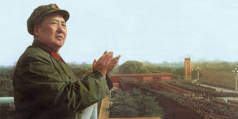
Trump’s Cultural Revolution
Donald Trump has upended seven decades of US foreign policy in a matter of weeks, leaving global leaders aghast and bewildered. But while his actions may seem unparalleled, there is a precedent for his political blitzkrieg: Mao Zedong, who had an even more impressive penchant for chaos and disruption.
NEW YORK – When US President Donald Trump’s factotum, J.D. Vance, held forth on Europe’s “threat from within” at the recent Munich Security Conference, his audience was left struggling to make sense of America’s confounding new approach to foreign policy. Chinese President Xi Jinping, for his part, has been relatively silent since Trump’s return to the White House – but that doesn’t mean he is any less vexed by what it portends. Nor could he have been reassured by Trump’s brazen response to a question last October about what he would do if Xi blockaded Taiwan: “Xi knows I’m fucking crazy!”
The Senate Majority Whip, John Barrasso, put it more decorously: “President Trump clearly ran for office to be a disrupter, and he’s going to continue to do that.” He is not wrong. In the first ten days of his second administration, Trump signed more than 50 executive orders; offered all federal workers a buyout; attempted to freeze funding that had already been allocated by Congress; threatened tariffs against numerous countries; and rattled allies with endless other insulting diktats.
But there is a precedent for Trump’s political blitzkrieg: Mao Zedong. While Mao, who launched China’s violent Cultural Revolution, and Trump share little in the way of geography, ideology, or hairstyle, they can both be described as agents of insurrection.
Mao’s penchant for disorder was deeply rooted in his troubled relationship with his father, whom he described to writer Edgar Snow as “a severe task master” and a “hot-tempered man” who beat his son so brutally, he often ran away from home. But Mao learned from this “war” how to stand up for himself: “When I defended my rights by open rebellion my father relented, but when I remained meek and submissive he only cursed and beat me more.”
This formative childhood experience shaped Mao as a person and drew him to the oppositional politics that helped catalyze the chaos and disorder that engulfed China for decades. As the American academic and diplomat Richard Solomon wrote at the time of the Cultural Revolution, “Thus, one unique individual’s efforts to break the bonds of personal subordination found larger meaning in a nation’s struggle to overcome political subordination.” Here, it is worth noting that during his formative years, Trump, too, had a bullying father who repeatedly told his sons that they would succeed in being “kings” only by being “killers.”
During his youth, Mao became a great admirer of the Monkey King, Sun Wukong, from the classic Chinese novel Journey to The West (西游记). Mao was so enamored of the rebellious and magically endowed Monkey King, whose mantra was “Create great disorder under heaven” (大闹天宫), that he ended one of his poems with, “We hail Sun Wukong, the wonder-worker!”
The peasant insurrection that Mao launched against Chiang Kai-shek’s Nationalist government in the 1920s was just the beginning of his so-called “permanent revolution” (不断革命), and many ruinous political campaigns and power struggles followed his founding of the People’s Republic of China in 1949. In 1957, the Anti-Rightist Campaign persecuted hundreds of thousands of intellectuals, while from 1958 to 1962, the “Great Leap Forward” (大跃进) to collectivize agriculture resulted in more than 30 million deaths from starvation and famine-related illnesses.
But his most epic political upheaval was the 1966 Great Proletarian Cultural Revolution, launched in response to what he saw as his fellow leaders’ bureaucratic resistance to his absolutism. He wrote the first “big-character poster” (大字报), calling on China’s youth to rise up and “bombard the headquarters” (炮打司令部) of the very party he had helped found. In the violence and chaos that followed, many leaders, such as President Liu Shaoqi and CPC General Secretary Deng Xiaoping, were purged, while others – including Xi’s own father, vice-premier Xi Zhongxun – were thrown into endless “struggle sessions,” sent off to May Seventh Cadre Schools (五七干校) for “rectification and thought reform” (思想改造), imprisoned, or even killed.
Certain of the righteousness of his crusade against what Trump supporters would call the “deep state,” Mao published a column in the People’s Daily newspaper counseling that there is “no need to be afraid of tidal waves. Human society has been evolved out of tidal waves.”
Mao’s abiding belief in the power of resistance led him to celebrate conflict. “Without destruction, there can be no construction” (不破不立), he proclaimed. Another vaunted slogan of the time declared: “World in great disorder: excellent situation!” (天下大乱形势大好). This impulse to disrupt or “overturn” (翻身) China’s class structure proved massively destructive. But Mao justified the resulting violence and upheaval as essential elements of “making revolution” (搞革命) and building a “New China.”
The Trump administration has an equally voracious appetite for disruption and chaos. Palantir CEO Alex Karp, whose co-founder Peter Thiel is also a Trump acolyte, recently described the new president’s overhaul of the United States government as a “revolution” in which “some people will get their heads cut off.” And this revolution’s executioner-in-chief would appear to be the world’s richest person, Elon Musk.
Despite obvious differences, Musk is more than a little reminiscent of Kuai Dafu, who was deputized by Mao himself to lead Tsinghua University’s Red Guard movement. Kuai not only brought chaos to his campus, but led 5,000 fellow Red Guards into Tiananmen Square shouting slogans against Liu and Deng, before attempting to lay siege to the nearby leadership compound, Zhongnanhai – much as Trump’s own version of the Red Guards did at the US Capitol in 2021.
Given that Xi came of age during Mao’s Cultural Revolution and was himself shipped off to the countryside to “eat bitterness” (吃苦) for seven years as a youth, he undoubtedly learned a thing or two about coping with such chaos. Still, Xi may have a hard time fully comprehending that the US – a country many Chinese have long admired, even using the expression “the moon is rounder in America than in China” (美国的月亮比中国的月亮圆) – has now produced its own grand progenitor of top-down turmoil.
Trump may lack Mao’s skills as a writer and theorist, but he possesses the same animal instinct to confound opponents and maintain authority by being unpredictable to the point of madness. Mao, who would have welcomed the catastrophe now unfolding in America, must be looking down from his Marxist-Leninist heaven with a smile, as the East wind may finally be prevailing over the West wind – a dream for which he had long hoped.
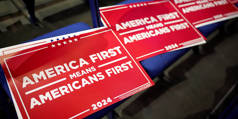
“America First” in Action
Donald Trump’s shutdown of US foreign aid and withdrawal from the Paris climate agreement and the World Health Organization will damage, perhaps irreparably, US influence in global forums. Far from making America great again, Trump is giving a giant boost to China’s claims to world leadership.
MELBOURNE – Donald Trump has wasted no time clarifying what “America First” – the dominant idea driving his election campaign – means in practice. So far, it means a 90-day freeze on most foreign aid spending, as well as the withdrawal of the United States from the World Health Organization (WHO) and the Paris climate agreement.
The ostensible purpose of the foreign aid freeze is to review the efficacy of US programs. I am a strong advocate for getting the best value for every dollar available to assist people in poverty. I founded The Life You Can Save to promote that idea and enable individual donors to find the most cost-effective charities combating extreme poverty.
But reviewing aid programs takes time and expertise. It is not possible to conduct an adequate review of all the aid programs that the US funds in three months, and to freeze spending while waiting for the review to be completed is an irresponsible way to manage aid that is often life-saving.
The freeze has already disrupted programs that prevent deaths from AIDS, tuberculosis, and malaria in many poor countries. Thousands of health-care and aid workers have been placed on leave without pay. Many will have to find other work to support themselves, so even if programs survive the review and funds are restored, their expertise may be lost.
Ongoing clinical trials have had to stop, which means that months or even years of work have been wasted. An administration that had any real concern for the well-being of those assisted by US aid would have left funding in place, pending the outcomes of the reviews.
It is not as if there was an urgent need to cut official US foreign aid for fiscal reasons. When Americans are asked what proportion of US government spending goes to foreign aid, the average answer is 25%, and when asked what they think an appropriate level would be, they say 10%. The truth is that official foreign aid amounts to only around 1% of the US budget.
The United Nations’ target for wealthy countries’ official foreign-aid spending is 0.7% of gross national income (GNI), or 70 cents of every $100 that the country earns. In 2023, the most recent year for which data are available, only Norway, Luxembourg, Sweden, Germany, and Denmark surpassed that figure. The US gave only 0.24% of its GNI in official aid, below several less affluent countries, including the United Kingdom, Japan, and Poland.
Likewise, withdrawing from the WHO will save very little money. The WHO’s annual expenditure is roughly half that of the health department of the US state of Rhode Island, which has a population of 1.1 million, and US contributions amount to only 15% of the WHO budget.
The US withdrawal will significantly reduce international cooperation on health issues, and will deprive US health authorities of information about disease prevalence abroad, which could mean that Americans are less informed about risks when they travel. But pharmaceutical companies outside the US may benefit, because withdrawal will remove America’s voice from discussions within the WHO on evidence and quality standards for new drugs – a voice that American pharmaceutical companies have previously used to give themselves a competitive edge over international rivals.
Of all the decisions made by Trump thus far, the most catastrophic are likely to be those related to climate change, including pushing for more oil and gas production (even allowing this to override the Endangered Species Act); removing tax credits for electric vehicles; and, above all, withdrawal from the Paris agreement. US per capita greenhouse-gas emissions are 50% higher than China’s, and almost seven times those of India. Those countries’ leaders will now be able to argue that there is no reason why their own, less affluent, economies should forego fossil fuels if the US is not going to be bound by the targets it accepted in Paris and at subsequent international climate conferences. Other, smaller countries will then say that their emissions are insignificant compared to those of the US, China, and India. Why should they do what the world’s largest emitters are not doing?
Ironically, given that these actions have been taken in the name of “America First,” they are contrary to America’s true long-term interests. Over the coming decades, Americans will swelter through hotter summers, struggle with more severe storms and floods, battle even worse wildfires than those that recently gutted swaths of Los Angeles, and retreat inland as rising sea levels inundate low-lying coastal areas, including Trump’s Mar-a-Lago resort and much of South Florida.
The US has greater capacity to cope with the effects of climate change than poorer countries. Still, the outcome will be far worse for Americans than the much more limited costs of complying with international agreements to mitigate the severity of climate change.
Taken as a whole, Trump’s policies will damage, perhaps irretrievably, whatever claims the US had to be listened to in global forums. His decisions will only confirm the views of those who have been saying for decades that the US government is a short-sighted, self-seeking plutocracy.
None of this will make America great again. On the contrary, Trump’s return to the White House has given a giant boost to China’s claims to world leadership.
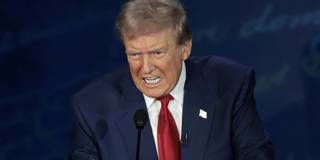
“He who saves his Country does not violate any Law,” US President Donald Trump recently posted. Saving America evidently includes purging the federal workforce, shuttering government agencies, freezing congressionally approved spending, giving private citizens access to critical government systems, ending birthright citizenship, threatening to deport student protesters, and stoking tensions with allies and trade partners.
With his unprecedented effort to push the limits of executive power, explains Richard K. Sherwin of New York Law School, Trump is “seeking to alter America’s constitutional framework of checks and balances among co-equal branches of government” – a change that he “lacks constitutional authority to execute.” With the Trump administration indicating that it will not listen to the courts, restoring the US “democratic republic” will require the American people to assert their “original sovereign power, through elections, mass protest, or other forms of collective action.”
But effective collective action requires the public to know what is going on, and as J. BradfordDeLong of the University of California, Berkeley, points out, it is difficult to “inform the public and advance public reason” when 10% of Trump’s “performative con-artistry” is “destructive chaos,” and the rest is “mirage.” At the same time, the media is putting too little effort into discerning “which Trump pronouncements are backed by dedicated policymaking teams and bureaucracies with the intent to follow through, and which are not.”
Whatever the details, warns Ian Buruma, Trump’s second presidency will “test, and perhaps destroy, people’s faith in American democracy and its universalist claims.” By tearing down America’s “civic religion,” he is “laying the groundwork for another quasi-religious belief: unquestioning fealty to an autocratic ruler.”
It is perhaps fitting, then, that the Asia Society’s Orville Schell draws parallels between Trump and history’s deadliest autocrat: Mao Zedong. Much like Trump’s “political blitzkrieg,” Mao’s Cultural Revolution was essentially a “crusade” against the “deep state,” carried out by a leader with an “animal instinct to confound opponents and maintain authority by being unpredictable to the point of madness.”
It is today’s China that stands to benefit from Trump’s “America First” agenda, observes the philosopher Peter Singer. Far from “making America great again,” the “shutdown of US foreign aid,” withdrawal from the World Health Organization, and abandonment of climate action will vindicate the view that the US government is a “short-sighted, self-seeking plutocracy” and provide “a giant boost to China’s claims to world leadership.”